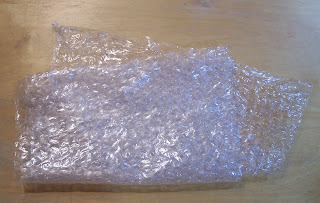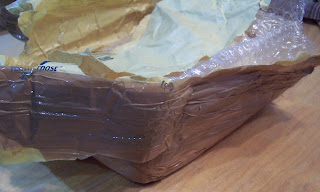If you landed here inadvertently, but like toy soldiers and vehicles, check out the following links:
Else, go on and find out how to make your own toy soldiers!
Some years back I got the itch to learn how to cast figures on my own. What prompted me to try this was the fact that I was having trouble finding more Airfix Italian guys. These figures have been out of production for many years and they are really hard to come by. At the time I had not really discovered eBay's scheduled searches, so this seemed like a good alternative. I had a handful of original figures which I had purchased at a local toy soldier show which could be used to seed my army. Out of principle I would never copy a figure that is still in production, and certainly never with the intent of reselling, regardless of whether it is still in production or not. The best way to keep the hobby going is to support the manufacturers that continue to produce figures today. Having said that, if you ever need to clone a figure that you can't get some other way, this is one way it can be done. Note that I have only attempted this once (it is a good amount of work), so I am by no means an expert. I am just passing on the knowledge I acquired. And I should also give credit, where it is due: Sheperd Paine's book 'How to Build Dioramas'. It is a great resource.
Part I - Making the Mold
The first thing you need to do is make a 'bed' of modeling clay into which you will insert the figures you want to copy. The picture here shows the one I used (the original figures would also be present). I cut it into three parts when I put it away, but in reality it would be one whole piece. You will need to be careful to insert the figures in a way that none of the resulting mold will be trapped under the figure. This means that figures are sunk into the clay at different depths. While the natural inclination might be to leave half of the figure above the clay, in reality sometimes more and sometimes less than half the figure sticks out of the clay, and sometimes a part of a figure needs to be deeper than the rest of the body and viceversa. The original figure usually has a fine line showing where the two halves of the original mold met, so that will give you an idea of how to set the figures in the clay. You will also need to make a few indentations that will serve to lock the two halves of your mold in place (see vertical arrow). The other thing that you will need, is a strip of plastic or clay (not shown in the picture) to place where the horizontal arrow is, which will create the necessary space for the 'pouring sprue'.
The next thing you need is to build a box around the clay with enough elevation to hold the liquid rubber that will be poured on top of it. There are several ways of building such a box. This worked well for me since I was making a long mold. BTW, I should probably mention here that in retrospective it might be better to make individual molds for each figure. I initially thought that it would be more efficient to make a big one for the whole set. While it is true that making individual molds will use up more time and material, it will also be easier/cheaper to make a second mold of one figure if the first one does not turn out 100% to your satisfaction, which is likely be the case with your first tries.
To keep the box in place you can use a set of clamps. You really want to keep it all stable and tight.
Then you need your liquid rubber. I used a product made by Smooth-On. They used to have a great starter kit that they would mail you for free with all the substances that you need and lots of instruction material. This box contained enough liquid rubber to make one half of the mold, so I still had to purchase a second box.
The liquid rubber comes in two bottles that will turn into solid when you mix them. The curing time for the rubber was fairly long that you do not need to worry about pouring it super quickly. The liquid plastic is another story, but we will get to that further below.
As I said, the Smooth-On products come with plenty of instructions. From a simple high-level summary in the back of the box to more detailed printed materials that guide you through the process.
Before you pour the liquid rubber on top of the clay/figures, you will want to coat then with the Sealing Agent (also from the Smooth-On starter kit), which makes sure that the rubber won't stick to the clay or the figures.
After pouring you will let it cure for several hours (see rubber instructions for precise time). This is how the first half looks after you flip it upside down and remove the layer of clay. Note that you should leave the figures in there. If you remove them it will be hard to set them back exactly as they were. Also the plastic or clay for the pouring sprue should remain in place.
Next you will want to assemble your super box around the first half of the mold in preparation for pouring another batch of liquid rubber to make the second half of the mold.
This time you will want to cover the lower half of the mold with the Mold Release Agent (bottle on the right). BTW, they both come with a spray cap.
After pouring the second batch of liquid rubber and letting it cure, you can then remove the figures and the plastic or clay for the pouring sprue and you should have two halves that match each other nicely. The pegs that stick out on one of them fit into the holes on the other one and keep it all well in place.
Then comes a scary part. You will need to cut pouring channels into your mold, joining the figure cavity to the pouring sprue. As you can see, I cut two per figure. One of them is to pour in the liquid plastic. The second one is to let the air escape. I cut them large to allow the plastic to go in quickly. What I later realized is that it wasted quite a bit of plastic and also made it hard to cut them off from the final figure. So perhaps shorter (setting the figures closer to the pouring sprue) and thinner might have worked out better.
It was after I cast my first figures that I ran into the real challenges. I kept getting air bubbles in my cast figures. The liquid plastic that I was pouring was quickly blocking both ducts, preventing the air from escaping. So I had to cut additional air escape ducts from where the air was getting trapped, usually the lowest points in the figures, or places where the plastic has to flow back up. If I were to do it all over again, I might have cut the air escape ducts in a better way. It got a bit messy and complicated, but hey, I was learning on the fly and I was really scared of ruining the molds.
Part II - Casting the Figures
OK, so next comes the step about pouring the liquid plastic. You will need to assemble your two halves into one, and hold it tight in place. To do that I made another wooden box that was held in place with a bigger set of clamps. Remember to coat both halves of your mold with the Release Agent. This will not only make it easy to remove the figures, but it will also preserve your mold, otherwise it starts to get little tears each time you remove a figure and those marks will show on the next figures you cast.
Then you are ready to pour. You will want to do so through one of the holes that you made on each figure. The liquid plastic also comes with the Smooth-On starter kit in two separate bottles that harden when you mix them. Note that they react within minutes, so you really need to work very fast. BTW, when you mix the liquid plastic that is also when you add a few drops of the color that you want for your figures. The plastic is some shade of white, so I added a handful of black drops into the mix which resulted in a light grey.
So here is another mistake I made. The first time I poured the plastic I just emptied my mixing container on top of the pouring sprue. This was a bad idea. The first problem is that it blocked the air escape ducts, so the plastic never made it in. The second problem is that it created this block of wasted plastic the size of the pouring sprue.
Then I switched to injecting the plastic. I had to get a bigger syringe to hold enough plastic for all the figures. This was not without complications. If I was not fast enough and the plastic hardened within the syringe it was very difficult to clean up and after a while the tip of the rubber plunger stopped working properly (it would remain inside when I pulled the plunger out). But if you work quickly and can replace the syringe a few times, then this method worked OK. I would also recommend getting a plastic type with a longer curing time, even it it means waiting longer between each batch of figures that you cast (had I known better at the time!). Anyhow, after you pour the plastic, then you just wait the prescribed time, disassemble your box/mold and remove your figures. You will then need to cut off any plastic that remains attached to them from the injection/air ducts.
Part III - The Result
The clone is on the right. All the casts I made of this figure have that bubble on the chin. I think that was a defect on the mold, rather than an actual air bubble. After I took the picture I noticed that the house on the background (which is made of injected foam) also has similar defects on its stones.
It would be misleading to only show the pictures of the figures that turned out well. For every one that turned out acceptable, there were two or three that had some unacceptable defect. I believe I could get the success rate higher with a few adjustments, but for now I have the figures I wanted so no need to keep experimenting. And about casting other hard-to-find sets, if I can find them on eBay I'll gladly spare myself all this effort!
This is just another type of box that you can use to make your mold. It is too deep and too big for an individual figure, but the concept of how the parts fit with each other works well.
Here is a closer look at how it is built.
Click here to see a post about Clones and Recasts
Click here to see a post with the original Italian Infantry figures




















































